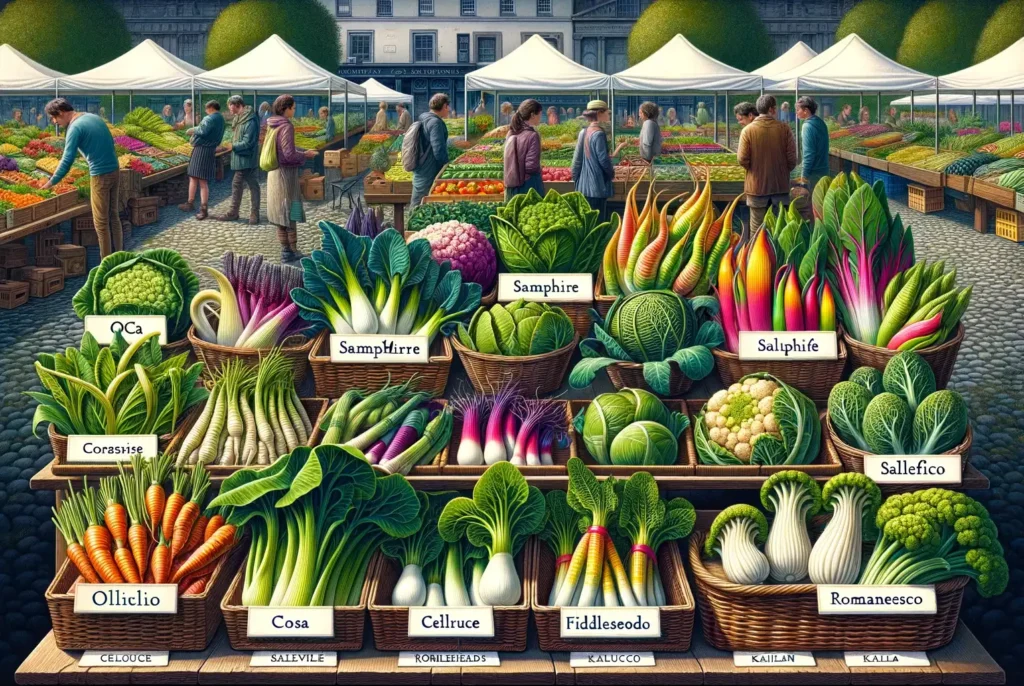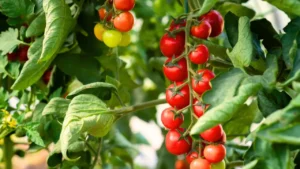
Here is the illustration of a farmers market showcasing a variety of rare vegetables including Oca Samphire Crosne Mashua Celtuce Salsify Fiddleheads Ulluco Romanesco and Kai lan.webp.webp

The Ten Most Rare Vegetables
- Oca (Oxalis tuberosa)
- Origin: Andes region of South America
- Description: Oca is a tuberous vegetable similar to potatoes, with a tangy, lemony flavor. It comes in a variety of colors, including red, yellow, and orange.
- Rarity: Difficult to find outside its native region and select specialty markets.
- Samphire (Salicornia europaea)
- Origin: Coastal regions of Europe and North America
- Description: Also known as sea asparagus, samphire is a succulent plant with a salty flavor, often used in salads and seafood dishes.
- Rarity: Grows in specific coastal environments, making it uncommon in mainstream markets.
- Crosne (Stachys affinis)
- Origin: China and Japan
- Description: Crosne, or Chinese artichoke, produces small, knobby tubers with a crisp texture and nutty flavor.
- Rarity: Limited commercial cultivation and often found only in specialty stores.
- Mashua (Tropaeolum tuberosum)
- Origin: Andes region of South America
- Description: A tuberous root vegetable related to nasturtiums, mashua has a peppery taste and is high in antioxidants.
- Rarity: Grown primarily in the Andes and rarely seen in global markets.
- Celtuce (Lactuca sativa var. asparagina)
- Origin: China
- Description: Also known as stem lettuce or asparagus lettuce, celtuce has a thick, edible stem with a mild, slightly nutty flavor.
- Rarity: Popular in Chinese cuisine but uncommon in Western grocery stores.
- Salsify (Tragopogon porrifolius)
- Origin: Mediterranean region
- Description: Often called the “oyster plant” due to its flavor, salsify has a long, tapering root that can be cooked like a parsnip.
- Rarity: Not widely grown or known, making it rare in many markets.
- Fiddleheads (Matteuccia struthiopteris)
- Origin: North America and Europe
- Description: The young, coiled fronds of the ostrich fern, fiddleheads have a flavor similar to asparagus and are highly seasonal.
- Rarity: Available only in early spring and often foraged rather than farmed.
- Ulluco (Ullucus tuberosus)
- Origin: Andes region of South America
- Description: Ulluco is a brightly colored tuber with a waxy texture and a taste somewhat like a combination of potatoes and beets.
- Rarity: Cultivated mainly in the Andes, with limited availability elsewhere.
- Romanesco (Brassica oleracea var. botrytis)
- Origin: Italy
- Description: Romanesco is a unique type of cauliflower with a fractal-like appearance and a mild, nutty flavor.
- Rarity: Less common than regular cauliflower and often considered a specialty item.
- Kai-lan (Brassica oleracea var. alboglabra)
- Origin: China
- Description: Also known as Chinese broccoli, kai-lan has thick, flat leaves and a slightly bitter flavor, used frequently in Asian cuisine.
- Rarity: More common in Asian markets and specialty stores than in mainstream Western markets.

How Rare Vegetables Can Enhance Your Culinary Experience
Incorporating rare vegetables into your diet can add unique flavors, textures, and nutritional benefits. These vegetables often have rich histories and cultural significance, making them not only a treat for the palate but also a way to connect with global culinary traditions. Exploring rare vegetables can enhance your culinary skills, provide exciting new dishes, and support biodiversity in agriculture by promoting the cultivation of diverse plant species.
Fall off the barn roof and busted your keister? Life on the farm or ranch can be tough on the bum. Need a break? Laugh it off at FarmerCowboy.com, the #1 farm humor site. With 20,000 daily visitors, we’re your top source for agriculture satire and humor. Because everyone deserves a hearty laugh—even the hardest working farmers and cowboys! Join us and turn those long days into fun tales at FarmerCowboy.com.
Originally posted 2024-05-30 05:37:31.
Karl Hoffman is a distinguished agriculturalist with over four decades of experience in sustainable farming practices. He holds a Ph.D. in Agronomy from Cornell University and has made significant contributions as a professor at Iowa State University. Hoffman’s groundbreaking research on integrated pest management and soil health has revolutionized modern agriculture. As a respected farm journalist, his column “Field Notes with Karl Hoffman” and his blog “The Modern Farmer” provide insightful, practical advice to a global audience. Hoffman’s work with the USDA and the United Nations FAO has enhanced food security worldwide. His awards include the USDA’s Distinguished Service Award and the World Food Prize, reflecting his profound impact on agriculture and sustainability.






